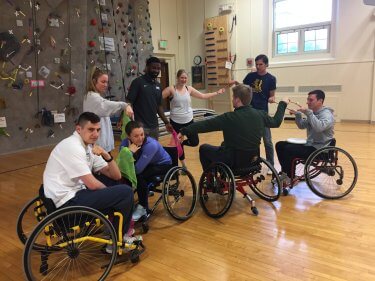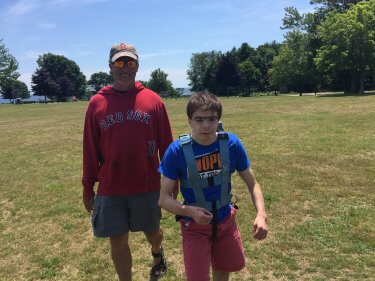Despite the call for Comprehensive School Physical Activity Programs (CSPAPs) to meet the needs of all students (AAHPERD, 2013; CDC, 2013), there is little practical guidance within our professional literature that directly promotes the inclusion of students with disabilities.
Central to the conversation on the value of CSPAP for students with disabilities are matters of health and well-being. Because students with disabilities face multiple barriers including mobility, skill acquisition and accessing the physical space, creating an environment of inclusivity is essential (Brian, et al., 2017). As such, it is imperative that all educators and CSPAP leaders include students with disabilities into their thinking and planning. One framework supporting all children is Universal Design for Learning (UDL); (Rapp, 2014).

Universal Design for Learning is a strategy that can support the inclusion of all children to meet daily recommendations of moderate to vigorous physical activity (MVPA) and contribute to SHAPE America’s 50 Million Strong by 2029 commitment. UDL’s concepts include multiple means of expression, representation and engagement. Most of all, it is a mindset that reinforces the need to provide equal opportunities to all of our students. Implementing UDL in educational settings will ensure that the physical, social, and learning environments are designed so that diverse learners are supported (Perez, 2014).
For students with severe disabilities, shifting attitudes are urgently needed because teachers traditionally have low expectations for their students’ learning capabilities (Block & Obrusnikova, 2007; Jorgensen, McSheehan, & Sonnenmeier, 2007). Many physical educators assume that students with disabilities do not have the requisite skills needed to access the curriculum or participate in sports and activities that many of their peers are participating in. UDL is achieved by varying teaching methods and providing materials that enable students to engage in any number of ways. When using a climbing wall for example, students can move horizontally, vertically, on the floor with poly-spots, or simply assisting their classmates by spotting. Equipment selection is considered that includes a variety of sizes, textures and sounds. Students’ responses (i.e. how students show what they can do) are viewed through communication mediums that align with the students’ preferred method of communication (Rapp, 2014). As trained educators, we should be able to analyze the task or activity in order to enhance learning for our students.

Teachers may also perceive that accommodating the needs of students with severe disabilities is too challenging or difficult to accomplish because of the needed supports (Hartman, 2015). To be a strong leader in developing inclusive environments, practitioners must be knowledgeable on accessibility guidelines for public facilities. The first concern is where the activity is going to take place. How accessible is the room and what is the spatial arrangement including lighting, noise level and physical location? Students should be able to access activities and equipment in ways that work for them. When teachers acknowledge learner variability and unique individual need, they address the foundations of diversity inherent in SHAPE America’s National Standards.
In terms of curriculum design, UDL is an approach for employing instructional strategies that allow learning goals to be attained by students whose differences may be include sensory, physical or cognitive impairments. UDL helps students learn the intended knowledge and skills by getting them to be interested in, and feel good about, the work they are doing (Rapp, 2014). Our hope is that this will increase the chances of success for students to pursue lifelong physical activity.
(Publishers Note: This article is based on a presentation made by the author as part of the 50 Million Strong by 2029 Forum held at the 2017 SHAPE America National Convention.)
References
Block, M. E., & Obrusnikova, I. (2007). Inclusion in physical education: A review of literature from1995–2005. Adapted Physical Activity Quarterly, 24(2), 103–124.
Brian, A., Lieberman, L., Grenier, M., Egan, C., & Taunton, S. (2017). 50 million strong for all: Universally designed CSPAP. Journal of Physical Education, Health Recreation, and Dance, 88(7), 30-36.
Hartman, E. (2015). Universal design for learning (UDL) and learners with severe support needs. International Journal of Whole Schooling, 11 (1), 54-67.
Jorgensen, C. M., McSheehan, M., & Sonnenmeier, R. M. (2007). Presumed competence reflected in the educational programs of students with IDD before and after the Beyond Access professional development intervention. Journal of Intellectual and Developmental Disability, 32, 248-262. doi:10.1080/13668250701704238
Lieberman, L. J., & Houston-Wilson, C. (2017). Strategies for Inclusion (3rd ed). Champaign, IL: Human Kinetics.
Meyer, A., Rose, D.H., & Gordon, D. (2014) Universal design for learning: Theory and practice, Wakefield MA: CAST.
Perez, K. (2014). The new inclusion: Differentiated strategies to engage ALL students. New York, NY: Teachers College Press.
Rapp, W. (2014). Universal design for learning in action. Baltimore, MD: Paul H. Brookes.
